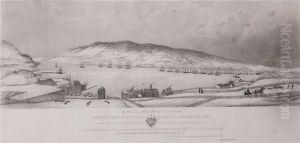William Gosse Paintings
William Christie Gosse (1842–1881) was not primarily known as an artist but as an English explorer and surveyor who played a significant role in the exploration of Australia during the 19th century. Born in London, England, Gosse moved to Adelaide, South Australia with his family in 1850 when he was just eight years old. His father, William Gosse, was a prominent figure in the medical field, which likely provided William with a stable upbringing and education.
Gosse's contributions to Australian exploration were significant. In 1873, he led an expedition into central Australia to find a path from Alice Springs to Perth, marking one of the early attempts to traverse the western and central parts of the continent. During this expedition, Gosse became the first European to sight Kata Tjuta (also known as the Olgas), a group of large, domed rock formations located about 365 kilometers southwest of Alice Springs. He named the highest peak Mount Olga, after Queen Olga of Württemberg.
Throughout his career, Gosse worked extensively as a surveyor, mapping vast areas of the Australian interior. His work helped to pave the way for further exploration and settlement of the area. Despite the hardships he faced, including harsh climates and difficult terrains, Gosse's contributions to the mapping and understanding of Australia’s geography were invaluable. He documented his travels and findings, which provided important insights into the Australian outback and its indigenous peoples.
William Gosse died in 1881 at the age of 39. Although his life was relatively short, his work had a lasting impact on the exploration and mapping of Australia. He is remembered not only for his contributions to Australian geography but also for the spirit of adventure and exploration that characterized his life and work. Gosse's legacy is a testament to the importance of exploration and the desire to understand the unknown.
